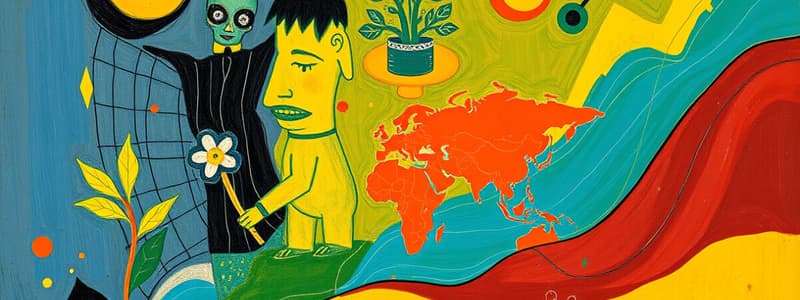Podcast
Questions and Answers
What does entrepreneurship involve?
What does entrepreneurship involve?
- Having an idea
- Taking a risk
- Producing something people need or want
- All of the above (correct)
What is scarcity?
What is scarcity?
Human needs/wants are always greater than resources will allow.
What does the term 'land' refer to in economics?
What does the term 'land' refer to in economics?
Any natural resource.
What does labor mean in the context of economics?
What does labor mean in the context of economics?
What is capital in economic terms?
What is capital in economic terms?
What is the study of economics focused on?
What is the study of economics focused on?
What is opportunity cost?
What is opportunity cost?
What does a production possibility curve depict?
What does a production possibility curve depict?
What is economic growth?
What is economic growth?
What does investment mean in economics?
What does investment mean in economics?
What is the relationship between price and quantity demanded?
What is the relationship between price and quantity demanded?
What is the relationship between price and quantity supplied?
What is the relationship between price and quantity supplied?
What are markets in economic terms?
What are markets in economic terms?
Who is an entrepreneur?
Who is an entrepreneur?
What are resources?
What are resources?
The three fundamental questions of economics are: ______
The three fundamental questions of economics are: ______
What does microeconomics study?
What does microeconomics study?
What is macroeconomics?
What is macroeconomics?
What is cost-benefit analysis?
What is cost-benefit analysis?
What are the non-price determinants of demand?
What are the non-price determinants of demand?
What is a shortage?
What is a shortage?
What is equilibrium in economics?
What is equilibrium in economics?
What does a graph of an indirect relationship depict?
What does a graph of an indirect relationship depict?
What does a graph of a direct relationship depict?
What does a graph of a direct relationship depict?
What are the non-price determinants of supply?
What are the non-price determinants of supply?
What is a surplus?
What is a surplus?
Flashcards are hidden until you start studying
Study Notes
Entrepreneurship
- Defined as having an idea, taking risks, and producing goods or services that fulfill people's needs or wants.
Scarcity
- Human needs and wants consistently exceed available resources, leading to economic challenges.
Land
- Refers to natural resources like wood and lead that are utilized in production.
Labor
- Represents the mental and physical capabilities of individuals engaged in work or production.
Capital
- Comprised of man-made tools and infrastructure, such as hammers, buildings, and delivery trucks, essential for production.
Economics
- The study of how scarcity affects choices; divided into microeconomics (individual and business decisions) and macroeconomics (overall economy).
Opportunity Cost
- Refers to the next best alternative that is forgone when a choice is made.
Production Possibility Curve
- A graphical representation that showcases maximum output possibilities for two goods, illustrating trade-offs and opportunity costs.
Economic Growth
- The capacity of an economy to increase production over time, indicating improved efficiency or resource utilization.
Investment
- Engaging in resource allocation today to ensure future growth and benefits.
Demand
- Describes the inverse relationship between the price of a good and the amount buyers are willing to purchase, represented by a negative curve.
Supply
- Indicates a direct relationship between the price of a good and the quantity sellers are willing to offer, depicted by a positive curve.
Markets
- Any venue or platform where buyers and sellers engage in transactions.
Entrepreneur
- An individual who organizes, manages, and takes on the risks of a business venture.
Resources
- Any inputs utilized in the production of goods or services, encompassing land, labor, and capital.
3 Fundamental Questions
- Essential inquiries of economics: What to produce? How to produce it? For whom should it be produced?
Micro-Economics
- Focuses on the economic behavior and decision-making processes of individuals and small entities, like businesses.
Macro-Economics
- Examines the economy as a complete system, including national and global economic issues.
Cost Benefit Analysis
- An economic model used to compare the marginal costs and benefits associated with a decision.
Non-Price Determinants of Demand
- Variables that can affect demand, including income levels, consumer preferences, related goods' prices, and demographic shifts.
Shortage
- Occurs when the quantity demanded of a good exceeds the quantity supplied, resulting in unmet consumer needs.
Equilibrium
- Represents a state where supply and demand are balanced, leading to stable prices.
Graph of an Indirect Relationship
- Refers to demand, illustrated by a curve with a negative slope.
Graph of a Direct Relationship
- Pertains to supply, represented by a curve with a positive slope.
Non-Price Determinants of Supply
- Factors influencing supply include the number of sellers, production technology, resource costs, taxation and subsidies, producer expectations, and potential alternative goods.
Surplus
- The situation where the quantity supplied surpasses the quantity demanded, often leading to excess inventory.
Studying That Suits You
Use AI to generate personalized quizzes and flashcards to suit your learning preferences.




